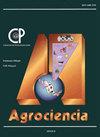In vitro CHEMICAL AND FERMENTATIVE CHARACTERISTICS OF TROPICAL PASTURES AT DIFFERENT AGES OF REGROWTH
IF 0.5
4区 农林科学
Q4 AGRICULTURE, MULTIDISCIPLINARY
引用次数: 0
Abstract
The low nutritive value of pastures in tropical regions represents a limitation in the productivity of grazing ruminants. The objective was to determine the in vitro chemical and fermentative characteristics of nine tropical grasses (Aruana [Panicum maximun Jacq. cv. Aruana], Bermuda [Cynodon dactylon L.], Estrella de África [Cynodon Cynodon nlemfuensis Vanderyst], Insurgente [Brachiaria brizantha Hochst. Stapf.], Llanero [Andropogon gayanus Kunth], Mombaza [Panicum maximun Jacq. cv. Mombaza], Pará [Brachiaria mutica Stapf], Pangola [Digitaria eriantha Steud.], and Tanzania [Panicum maximun Jacq. cv. Tanzania]) at three regrowth ages (30, 45, and 60 days). The chemical analysis was used to determine the concentrations of dry matter (DM), crude protein (CP), acid detergent fiber (ADF), neutral detergent fiber (NDF), and ash (Ce). The in vitro trial measured partial (24, 48, and 72 h) and cumulative biogas and methane production, fermentation kinetics estimators (A, b, and k), dry matter degradation (DMD) and detergent neutral fiber degradation (NDFD), pH, and ammonia nitrogen (N-NH3). The experimental design was completely randomized at each regrowth age. In conclusion, based on chemical analysis and fermentative characteristics, Pangola and Estrella pastures performed better at each regrowth age.热带牧草不同再生年龄的体外化学和发酵特性
热带地区牧草营养价值低,限制了放牧反刍动物的生产力。目的是测定9种热带禾本科植物阿鲁纳(Aruana [Panicum maximun Jacq])的体外化学和发酵特性。简历。Aruana, Bermuda [Cynodon dactylon L.], Estrella de África [Cynodon Cynodon nlemfuensis Vanderyst], Insurgente [Brachiaria brizantha Hochst.]。Stapf。], Llanero [Andropogon gayanus Kunth], Mombaza [Panicum maximun Jacq]。简历。蒙巴扎,parachiaria mutica Stapf, Pangola Digitaria eriantha Steud。),以及坦桑尼亚(Panicum maximun Jacq)。简历。在三个再生年龄(30,45和60天)。化学分析测定干物质(DM)、粗蛋白质(CP)、酸性洗涤纤维(ADF)、中性洗涤纤维(NDF)和灰分(Ce)的浓度。体外试验测量了部分(24、48和72 h)和累积的沼气和甲烷产量,发酵动力学估算值(A、b和k),干物质降解(DMD)和洗涤剂中性纤维降解(NDFD), pH和氨氮(N-NH3)。试验设计在每个再生年龄完全随机化。综上所述,根据化学分析和发酵特性,p安哥拉和Estrella牧场在各再生年龄表现较好。
本文章由计算机程序翻译,如有差异,请以英文原文为准。
求助全文
约1分钟内获得全文
求助全文
来源期刊

Agrociencia
农林科学-农业综合
CiteScore
0.50
自引率
33.30%
发文量
51
审稿时长
18-36 weeks
期刊介绍:
AGROCIENCIA is a scientific journal created and sponsored by the Colegio de Postgraduados. Its main objective is the publication and diffusion of agricultural, animal and forestry sciences research results from mexican and foreign scientists. All contributions are peer reviewed. Starting in the year 2000, AGROCIENCIA became a bimonthly and fully bilingual journal (Spanish and English versions in the same issue). Since 2007 appears every month and a half (eight issues per year). In addition to the printed issues, the full content is available in electronic format.
 求助内容:
求助内容: 应助结果提醒方式:
应助结果提醒方式:


